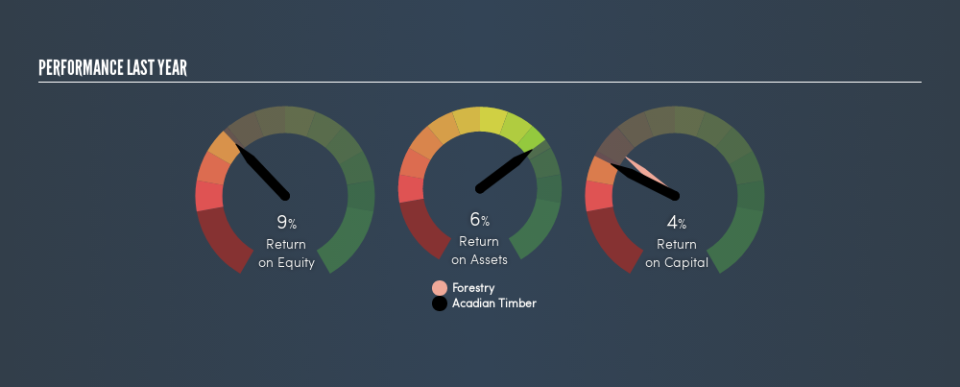Why Acadian Timber Corp.’s (TSE:ADN) Return On Capital Employed Looks Uninspiring

Want to participate in a short research study? Help shape the future of investing tools and you could win a $250 gift card!
Today we are going to look at Acadian Timber Corp. (TSE:ADN) to see whether it might be an attractive investment prospect. To be precise, we'll consider its Return On Capital Employed (ROCE), as that will inform our view of the quality of the business.
Firstly, we'll go over how we calculate ROCE. Second, we'll look at its ROCE compared to similar companies. And finally, we'll look at how its current liabilities are impacting its ROCE.
Understanding Return On Capital Employed (ROCE)
ROCE is a measure of a company's yearly pre-tax profit (its return), relative to the capital employed in the business. All else being equal, a better business will have a higher ROCE. In brief, it is a useful tool, but it is not without drawbacks. Author Edwin Whiting says to be careful when comparing the ROCE of different businesses, since 'No two businesses are exactly alike.'
So, How Do We Calculate ROCE?
Analysts use this formula to calculate return on capital employed:
Return on Capital Employed = Earnings Before Interest and Tax (EBIT) ÷ (Total Assets - Current Liabilities)
Or for Acadian Timber:
0.044 = CA$21m ÷ (CA$492m - CA$13m) (Based on the trailing twelve months to December 2018.)
So, Acadian Timber has an ROCE of 4.4%.
Check out our latest analysis for Acadian Timber
Is Acadian Timber's ROCE Good?
ROCE is commonly used for comparing the performance of similar businesses. We can see Acadian Timber's ROCE is meaningfully below the Forestry industry average of 10%. This performance is not ideal, as it suggests the company may not be deploying its capital as effectively as some competitors. Independently of how Acadian Timber compares to its industry, its ROCE in absolute terms is low; especially compared to the ~1.9% available in government bonds. There are potentially more appealing investments elsewhere.
It is important to remember that ROCE shows past performance, and is not necessarily predictive. ROCE can be deceptive for cyclical businesses, as returns can look incredible in boom times, and terribly low in downturns. ROCE is only a point-in-time measure. What happens in the future is pretty important for investors, so we have prepared a free report on analyst forecasts for Acadian Timber.
What Are Current Liabilities, And How Do They Affect Acadian Timber's ROCE?
Current liabilities include invoices, such as supplier payments, short-term debt, or a tax bill, that need to be paid within 12 months. Due to the way the ROCE equation works, having large bills due in the near term can make it look as though a company has less capital employed, and thus a higher ROCE than usual. To check the impact of this, we calculate if a company has high current liabilities relative to its total assets.
Acadian Timber has total assets of CA$492m and current liabilities of CA$13m. As a result, its current liabilities are equal to approximately 2.7% of its total assets. Acadian Timber has very few current liabilities, which have a minimal effect on its already low ROCE.
What We Can Learn From Acadian Timber's ROCE
Nevertheless, there are potentially more attractive companies to invest in. You might be able to find a better investment than Acadian Timber. If you want a selection of possible winners, check out this free list of interesting companies that trade on a P/E below 20 (but have proven they can grow earnings).
I will like Acadian Timber better if I see some big insider buys. While we wait, check out this free list of growing companies with considerable, recent, insider buying.
We aim to bring you long-term focused research analysis driven by fundamental data. Note that our analysis may not factor in the latest price-sensitive company announcements or qualitative material.
If you spot an error that warrants correction, please contact the editor at editorial-team@simplywallst.com. This article by Simply Wall St is general in nature. It does not constitute a recommendation to buy or sell any stock, and does not take account of your objectives, or your financial situation. Simply Wall St has no position in the stocks mentioned. Thank you for reading.

